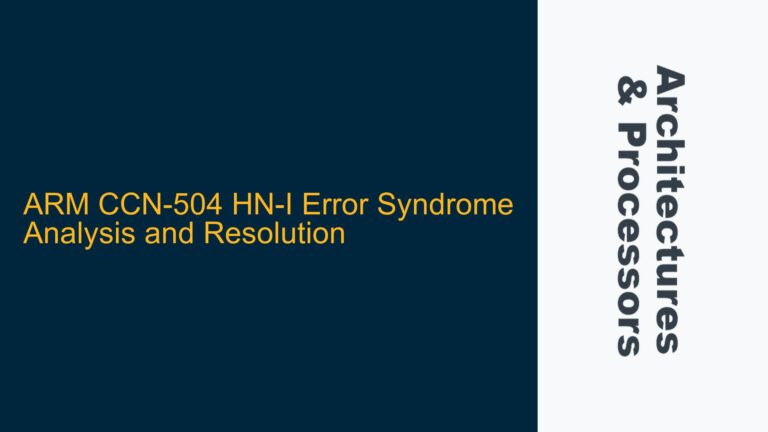QACTIVE Assertion and QDENY Dependency in AMBA Q-Channel
The AMBA Low Power Interface (Q-Channel) is a critical component in ARM-based SoC designs, enabling efficient power management by facilitating communication between power controllers and peripheral devices. The Q-Channel consists of several signals, including QACTIVE, QDENY, and PWAKEUP, which play pivotal roles in managing power states. A common point of confusion arises when understanding the relationship between QACTIVE and QDENY, particularly when both signals are tied to PWAKEUP. This section delves into the conditions under which QACTIVE is asserted and whether QDENY can be asserted simultaneously.
QACTIVE is a signal that indicates whether a device is actively processing transactions or is in a state where it can accept new transactions. When QACTIVE is asserted, it signifies that the device is operational and not in a low-power state. On the other hand, QDENY is a signal used by a device to reject a low-power state request from the power controller. The assertion of QDENY effectively prevents the power controller from transitioning the device into a low-power state.
In the scenario where QACTIVE and QDENY are both assigned to PWAKEUP, the relationship between these signals becomes intertwined. PWAKEUP is a signal that indicates whether a device is ready to exit a low-power state. When PWAKEUP is asserted, it implies that the device is either already active or is in the process of becoming active. Therefore, if QACTIVE is asserted (indicating the device is active), it is generally expected that QDENY should not be asserted simultaneously, as there would be no need to deny a low-power state request if the device is already active.
However, this relationship is not absolute and depends on the specific implementation and power management policies of the device. For instance, if the device is transitioning from a low-power state to an active state, there might be a brief period where both QACTIVE and QDENY are asserted. This could occur if the device is not yet fully operational but needs to prevent the power controller from initiating a low-power state transition during the wake-up process.
To summarize, while QACTIVE and QDENY are generally independent signals, their relationship becomes more complex when both are tied to PWAKEUP. The assertion of QACTIVE typically implies that QDENY should not be asserted, but there are edge cases where both signals might be active simultaneously, particularly during state transitions.
Conditions for Asserting QDENY in AMBA Q-Channel
Understanding the conditions under which QDENY is asserted is crucial for designing robust power management systems. QDENY is a signal that a device uses to reject a low-power state request from the power controller. The assertion of QDENY is typically governed by the internal state of the device and its readiness to enter a low-power state.
One of the primary conditions for asserting QDENY is when the device is in the middle of a critical operation that cannot be interrupted. For example, if a device is processing a high-priority transaction or is in the middle of a DMA transfer, it may assert QDENY to prevent the power controller from forcing it into a low-power state. This ensures that the device can complete its current operation without being interrupted by a power state transition.
Another condition for asserting QDENY is when the device is in the process of waking up from a low-power state. During the wake-up process, the device may not be fully operational, and asserting QDENY ensures that the power controller does not attempt to transition the device back into a low-power state before it is ready. This is particularly important in systems where the wake-up latency is significant, and the device needs time to stabilize before it can accept new transactions.
Additionally, QDENY may be asserted if the device is configured to operate in a specific power mode that is incompatible with the requested low-power state. For instance, if a device is configured to operate in a high-performance mode that requires a higher voltage level, it may assert QDENY to prevent the power controller from transitioning it into a low-power state that would reduce its performance.
It is also worth noting that the assertion of QDENY can be influenced by external factors, such as the state of other devices in the system. In a multi-device system, the power controller may coordinate power state transitions across multiple devices, and the assertion of QDENY by one device may impact the power management decisions for the entire system.
In summary, QDENY is asserted under specific conditions that are related to the internal state of the device, its current operations, and its configuration. Understanding these conditions is essential for designing effective power management strategies and ensuring that devices can operate reliably without being forced into inappropriate power states.
Implementing QACTIVE and QDENY Signals with PWAKEUP in AMBA Q-Channel
Implementing QACTIVE and QDENY signals in conjunction with PWAKEUP requires a thorough understanding of the AMBA Q-Channel protocol and the specific requirements of the device. This section provides detailed guidance on how to implement these signals effectively, ensuring that the device can manage power states efficiently while maintaining operational integrity.
Signal Assignment and Timing Considerations
When assigning QACTIVE and QDENY to PWAKEUP, it is important to consider the timing relationships between these signals. PWAKEUP is typically asserted when the device is ready to exit a low-power state, and it is used to signal the power controller that the device is becoming active. Therefore, QACTIVE should be asserted shortly after PWAKEUP is asserted, indicating that the device is now operational.
However, the timing of QDENY assertion is more nuanced. If the device is in the process of waking up, it may need to assert QDENY to prevent the power controller from initiating a low-power state transition before the device is fully operational. This requires careful coordination between the wake-up process and the assertion of QDENY.
State Machine Design
A well-designed state machine is essential for managing the transitions between different power states and ensuring that QACTIVE and QDENY are asserted appropriately. The state machine should include states for active, low-power, and transitional states, with clear conditions for transitioning between these states.
For example, when the device is in the active state, QACTIVE should be asserted, and QDENY should be de-asserted. When the device is transitioning to a low-power state, QACTIVE should be de-asserted, and QDENY should be asserted if the device is not ready to enter the low-power state. The state machine should also handle the wake-up process, ensuring that QACTIVE is asserted and QDENY is de-asserted once the device is fully operational.
Verification and Debugging
Verifying the implementation of QACTIVE and QDENY signals requires a comprehensive test plan that covers all possible power state transitions and edge cases. This includes testing the device’s response to low-power state requests, its behavior during wake-up, and its ability to assert QDENY when necessary.
Debugging issues related to QACTIVE and QDENY can be challenging, particularly when these signals are tied to PWAKEUP. It is important to use simulation tools that allow for detailed analysis of signal timing and state transitions. Additionally, logging the state of the device and the assertion of QACTIVE and QDENY can help identify issues and ensure that the device is behaving as expected.
Best Practices
To ensure a robust implementation of QACTIVE and QDENY signals, consider the following best practices:
- Clear Documentation: Document the conditions under which QACTIVE and QDENY are asserted, including any dependencies on PWAKEUP and other signals.
- Thorough Testing: Develop a comprehensive test plan that covers all possible power state transitions and edge cases.
- Simulation and Analysis: Use simulation tools to analyze signal timing and state transitions, and log the state of the device for debugging purposes.
- State Machine Design: Design a state machine that clearly defines the conditions for transitioning between different power states and the assertion of QACTIVE and QDENY.
- Coordination with Power Controller: Ensure that the device’s power management logic is coordinated with the power controller, particularly when asserting QDENY to prevent inappropriate power state transitions.
By following these guidelines, designers can implement QACTIVE and QDENY signals effectively, ensuring that the device can manage power states efficiently while maintaining operational integrity. This approach not only enhances the reliability of the device but also contributes to the overall power efficiency of the SoC.






